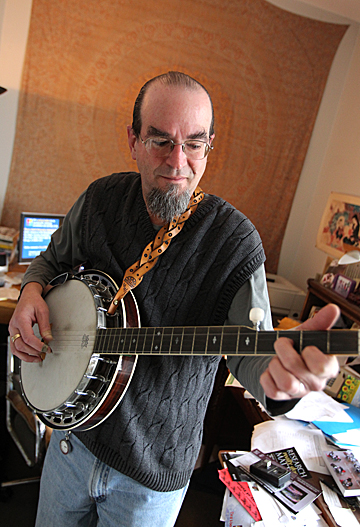
Dr. Stephen Christman played a little bluegrass on the banjo. His research on handedness and music found that those who use their nondominant hand for a few daily activities are more open to listening to different genres of music like bluegrass.
According to Dr. Stephen Christman, UT professor of psychology, the size of the corpus callosum — the bundle of nerve fibers in the brain that serves as the primary connection between the left and right cerebral hemispheres — influences not only how individuals use their hands, but also how open a person is to unfamiliar musical genres.
Christman’s study linking handedness and musical taste was published in the journal Psychology of Music and garnered national attention from news organizations MSNBC and The Huffington Post.
The bigger the corpus callosum, according to Christman, the greater the interaction possible between the left and right sides of the brain — which leads to greater access to right hemisphere processing.
“The right hemisphere plays a key role in the updating of beliefs, and increased access makes a person more open to persuasion and new experiences — such as listening to a new musical genre,” Christman said.
“The left hemisphere, conversely, is in charge of maintaining our current beliefs and strives to interpret information in terms of those beliefs,” he continued. “If enough contradictory evidence accumulates, the right hemisphere can force an updating of the left hemisphere-based beliefs — which may include an appreciation for a newly discovered musical style.”
People with large corpus callosums also are disposed to be mixed-handed; roughly half of all people are mixed-handed. According to Christman, this refers to the use of the nondominant hand for at least one common manual activity such as writing, drawing, throwing, opening jars, combing hair, brushing teeth, striking a match and using eating utensils. It does not, however, refer to ambidexterity.
Strong-handed individuals will use their dominant right or left hands regularly for all such activities while mixed-handed individuals use their nondominant hand regularly for at least one such activity.
Christman’s hypothesized link between handedness and musical preferences was corroborated by a study he performed on 92 UT students. The strong-handed students cited R&B, modern pop and alternative rock as their top three musical choices while the mixed-handed students were more favorable to less familiar genres such as bluegrass and reggae.
Christman is planning a follow-up study to see if similar effects can be found with popular versus obscure films as well as with popular versus obscure authors and books.